Metadata
Video captions: In VRED 2023.3, we added the completely new so-called Metadata Editor. Metadata is information that is attached to a node that can be used to extend workflows or pipeline scripts, while being object name independent. So, with the Metadata Editor, you can create, edit, and control metadata, which is information that is attached to objects, that is normally hidden. I can also use existing metadata that are coming from external CAD applications like Catia or Inventor, and within the Metadata Editor, I can create metadata sets to arrange them to my needs or to search for specific information.
Here is how it works: I can now search and filter nodes without knowing the name of the nodes, by using the metadata information. This can be done using our new advanced search widget, which uses simple Python expressions to search for metadata information. So, I can, for example, search for a specific owner or author. Like here, where I am searching for my name. Now, I see hundreds of nodes. But I can also specify it a bit more and add a date to my search. So now, I only see objects that I have created at this specific date.
And, this advanced search is now implemented in all corresponding editors like the Scenegraph, Material, Camera, Light, and Sceneplate Editor. Or I want to filter for a specific part, like here, the generative design wheels, and in case I need this filter more often, I can also save that query search as a favorite and use the same search within the Material Editor, to find out where the materials of that objects are. So, it’s all about a name independent advanced search and what I do with this, strongly depends on my workflows and also my creativity.
I give you a practical example: Here, I am creating a metadata set for a specific variant or version of the car by simply dragging and dropping the related nodes or materials into the metadata set. In this case, I am adding different wheels and several material switches to my sets. And for a better overview, I can change the color of the sets. Additionally, for future use, I can save the metadata sets or store them in the Asset Manager.
And now, I can use a Python script that controls the visibility of the nodes within the metadata set, and this gives me the possibility to show different car variants without the need to rearrange nodes within geometry switches. This can keep the scenegraph complexity very low, and this can be even more helpful when variant switches of a car are getting extremely complex.
Here is another example: When loading a Substance material into VRED, I can see that the texture size is still the default 100 mm. But in the metadata of the material, I can see the real values written in cm. Now, I can run a script that reads out this information, converts them into mm and writes that into the size field of the material and you will have instantly the right size.
And also a roundtrip with Maya is possible. So, I can read the VRED metadata from an exported FBX part within Maya, edit them there, reimport the parts to VRED, and I can see the new metadata entries from Maya in VRED, now as well. So generally, we have now an editor that can use this hidden metadata information and you can decide what to do with this new selection and filtering ability, depending on your workflows and needs.
Use the Metadata Editor to manage key/value and query searches for specific information. It reduces Scenegraph complexity, controlling scene configuration and variants. Add custom sets, create and save favorites, as well as search and filter metadata.
For how to perform an advanced search, see Using Advanced Search.
Loading Metadata Sets
Use Load Metadata Sets to load metadata from other projects or colleague into your current project. Work with multiple metadata sets, including imported metadata from CATIA, DGN, Inventor, IGES, JT, NX, CREO, SolidEdge, SolidWorks, STEP, and PLMXML.
- Select File > Load Metadata Sets and choose a .json file containing metadata sets.
- Click Open to load the file into your current project.
When importing files containing Substance metadata, if you want it to be imported, ensure the preference, Import Metadata, is enabled.
Saving Metadata Sets
Use Save Metadata Sets to reuse, edit, and/or share your metadata sets with colleagues. Since your metadata sets are saved to a .json file, you can work on them outside of VRED, using a text editor.
- Select File > Save Metadata Sets and choose a location for the metadata .json file.
- Name the file and click Save.
Creating Sets and Entries
Use Create Set and Create Entry to add information to a file to help colleagues know more about a part, such as the expected material assignment and color. The addition of component information captured in the metadata can help reduce interuptions by minimizing the need for clarification emails and create a software-agnostic pipeline integration.
Use the Metadata Editor API to add metadata for variants, that in turn, can be scripted to trigger the variants. By assigning metadata and tags, there is no longer a need for deep, complex hierarchies, as the metadata can be toggled on or off, making switches unnecessary, flattening the hierarchy, and improving the performance of your scene.
Use Create Entry to define the metadata set with key/value pairs. The key is the keyword or instructions added to the set and the value is the definition of that keyword.
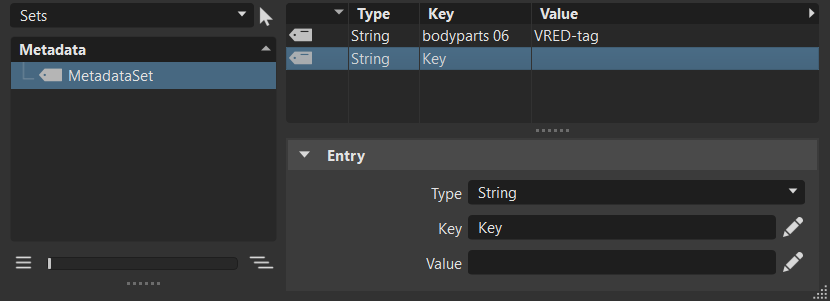
- Select either an object or set in the tree.
- Right-click, select Create Set, and name the set or select Create Entry, choose a type, then enter a key and the value information.
Assigning Sets
For data prep, use Assign Sets to to help flatten the scenegraph by assigning created metadata sets to specific objects, such as to lights, cameras, a part, or backplate. The metadata sets can be used in place of switches (with deep hierarchies) for variant switching via scripts. The reduced scenegraph complexity results in significantly increased performance.
Select Edit > Assign Sets to and choose where the sets are assigned, from your last selection, any selected nodes, materials, cameras, lights, or sceneplates.
You can also just drag and drop metadata sets onto objects in the List Tree.
Removing Metadata Assignments
Use Remove Selected Assignment to remove your selection (a metadata set or object-level entry) from all its assignments (parent node).
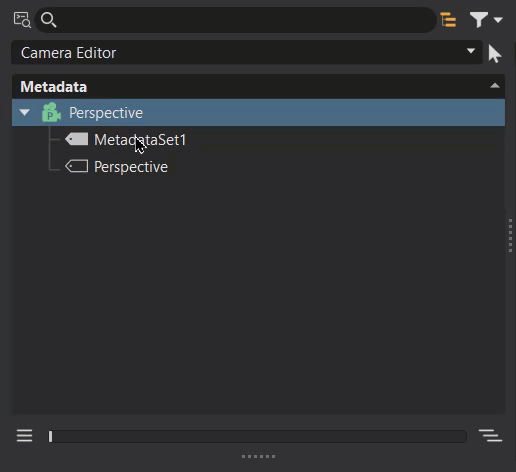
- In the tree, select a metadata set or object-level entry.
- Right-click and select Remove Selected Assignment.
Use Remove All Assignments to remove all assignments (metadata sets) from your selection (parent group node).
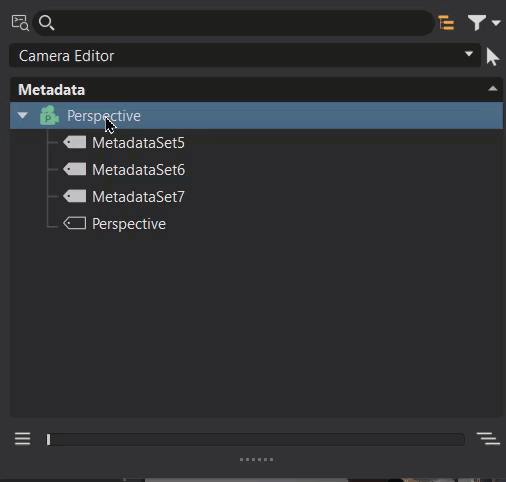
- In the tree, select a parent group node.
- Right-click and select Remove All Assignments.
Deleting All Entries
Use ![]() Delete All Entries to delete all key/value pairs for a set. This retains its object assignments, clearing only the entry keys and values. Now, you can create new metadata for that set, without affecting its assignments.
Delete All Entries to delete all key/value pairs for a set. This retains its object assignments, clearing only the entry keys and values. Now, you can create new metadata for that set, without affecting its assignments.
- Select
 (an object-level entry) or
(an object-level entry) or  (metadata set).
(metadata set). - Click
 (Delete All Entries). This removes the
(Delete All Entries). This removes the  (an object-level entry) and its entries from the group. If a metadata set was selected, the set remains, but its entries are deleted.
(an object-level entry) and its entries from the group. If a metadata set was selected, the set remains, but its entries are deleted.

Selecting Objects in Their Editors
Use Select Objects in to immediately find your selection in its editor. Keep in mind, the editor must be open to find your selection, as this option does not open the editor.
- Open the appropriate editor.
- In the Metadata Editor List Tree, select an object or set.
- Right-click and select Select Objects in.
Creating Asset Metadata Sets
Use metadata sets from the Metadata Editor to add metadata to assets. Drag sets into the Asset Manager's Metadata tab. Doing this changes the tag in the Metadata Editor to  .
.
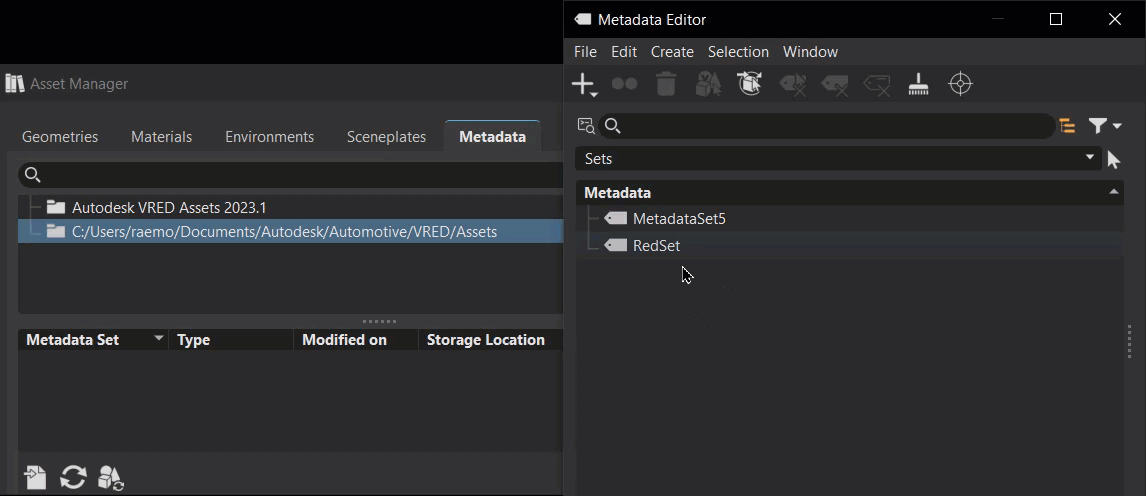
Editing and Reloading Asset Metadata Sets
Use the Asset Manager to make changes to a metadata set by editing its .json file, then reloading it, to update the information in VRED.
- To change an asset's metadata, in the Asset Manager Metadata tab, right-click the metadata file and select Open in Explorer.
- Edit the .json file in a text editor and save your changes.
- In the Asset Manager Metadata tab, select the changed asset set in the list.
- Click
 , Yes to replace the asset in your scene, then
, Yes to replace the asset in your scene, then  .
.
Displaying and Hiding Table Columns
Click ![]() to the right of the table column name to access a menu with a column list. Check an option to display the column and uncheck one to hide it.
to the right of the table column name to access a menu with a column list. Check an option to display the column and uncheck one to hide it.

Filtering Table Columns
For columns that can be filtered, click  to access a menu of options specific to that column.
to access a menu of options specific to that column.
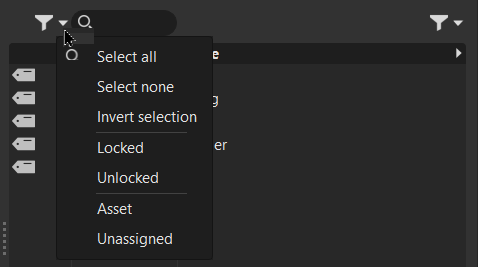
When the displayed content is filtered, ![]() changes to
changes to ![]() .
.
These options are common to both the Icon and Type columns.
- Select All - Enables all the filter settings, such as Locked, Unlocked, Asset, and Unassigned or String, Float, Date, etc.
- None - Deselects all filter settings, such as Locked, Unlocked, Asset, and Unassigned or String, Float, Date, etc.
- Invert Selection - Selects all unselected filter settings and deselects all selected settings.
These options are specific to the Icon column and can be used in combination with other filters to further refine your search.
- Locked - Displays all locked metadata sets in the graph.
- Unocked - Displays all unlocked metadata sets in the graph.
- Asset - Displays all asset metadata sets in the graph.
- Unassigned - Displays all unassigned metadata sets in the graph.
Selecting options specific to the Type column will display all metadata sets of that type. Therefore, if String is selected, only metadata sets with an assigned string type are displayed.
Searching Table Columns
Enter simple search term in the  field for the Assignment, Key, and Value columns. When the column is displaying search results, the
field for the Assignment, Key, and Value columns. When the column is displaying search results, the  changes to
changes to  .
.

To clear a search, either click the X next to the search term or delete the content in the search field.